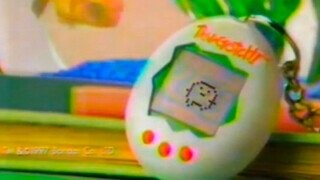Re-Visiting The Weird, Feared Time Of Tamagotchis

The Tamagotchi caught the heart of children while tightening the fists of frigid adults who swore the digital pet did more harm than good. Gracing the world with its charming neediness, the handheld virtual pet quickly became a child to other children. A pocket toy shaped like an egg with an even smaller screen reminiscent of a tiny television, the Tamagotchi needed attention day in and out, from being fed an array of healthy snacks like fruit and giving it cheat days with junk food. Eventually, the pets would grow, appearing more and more like aliens from another planet.
These dependent creatures made 90s kids believe they were little responsible parents, tending to them in ways unheard of, like virtually scooping up their droppings as if performing a diaper change on a baby. Released in 1996, 40 million Tamagotchis were purchased worldwide, and within the next 20 years, that number would climb to a whopping 82 million. Japanese toy company Bandai developed the product, originally thought up by toy designer Akihiro Yokoi and a clerical worker at Bandai, Aki Maita.
A backstory was even created for the Tamagotchis. Professor Banzo, described as a hopeless romantic, was dumped for the last time after a previous track record of having been dumped 100 times. Stewing in his despair, he trudged along the Sumida River of Japan, where he came across alien creatures in a UFO. And so, this became the supposed reason why Tamagotchis live inside of a virtual egg. Sad or adorable tale?
Don't Miss
Tamagotchis weren't as easy of a sell for some parents (even though the proof is in the pudding: they bought millions of dollars worth of them collectively.) But ignoring the obvious, parents and teachers grew worried by the demanding level of attention needed to take care of the pet. As most Tamagotchis held life spans as short as 30 minutes, students would sneak them in class to avoid this:
Most of the reasoning was also backed up by a strange theory. Psychologists feared that children would go through a mourning process after their Tamagotchi died. Neglecting it by not feeding it enough, leaving behind too many of its stinky diapers, or just plain not giving the attention-seeking monster enough hours in your day, you could end up with a dead Tamagotchi in minutes.
One variety of the virtual pet is a prime example, known as the Tamagotchi Angel. Having already virtually died, this Tamagotchi tries to do its best Swayze impression before reaching the afterlife, and if it ended poorly, the Tamagotchi would turn into a devil(tchi).
And, of course, the Tamagotchi needed eternal rest, like any other pet. Where would the deceased Tamagotchis end up? Why in the official Tamagotchi Cemetery. You're most likely thinking, "But you can just reset your Tamagotchi and make it live as many lives as possible?" And yes, that was a perk of raising this virtual pet, though, for hardcore owners who wanted to remember their pet as they were when they checked out, they insisted on proceeding with a proper burial.
A clear coffin, a small bouquet of flowers, and a brief service was held for these digital aliens. There existed a physical Tamagotchi cemetery and an online Tamagotchi memorial if you're too creeped out by your first option. And of your truly unsettled by Tamagotchi lore in the first place, maybe consider a goldfish instead.
For more of Oona’s sarcasm and attempted wit, visit her website oonaoffthecuff.com.
Top Image: Bandai